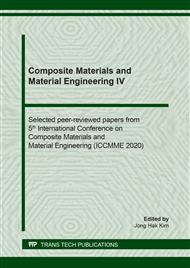p.3
p.9
p.15
p.22
p.28
p.34
p.40
p.46
Stress Analysis of a Flange Stiffened FRP Composite Panel with Varying Stacking Sequence
Abstract:
Large panel structures made of composites are common building units in aerospace industries. In order to increase the stiffness of such structures, the panel or skin is adhered to a flange and supported by a web. Such a stiffened panel is modeled as an arrangement of web, flange and panel with an interface between the flange and the panel. In this paper, three dimensional stress analysis of one such stiffened panel has been carried out using the finite element analysis. The geometric non-linearity has been assumed in the analysis. The effect of material anisotropy and the laminate stacking sequence on the stress components has been studied. Material Graphite Fiber Reinforced Polymeric (GFRP) composite has been used and, two different configurations were considered while the unidirectional prepregs were laid up in quasi-isotropic [0/0/0/0]2 and cross-ply [0/90/90/0]2. Subsequently, the coupled stress failure criterion has been used to predict the critical location of damage onset. When component damage indicator attained the value of 1.0, the component was considered to lose stiffness and structural integrity.
Info:
Periodical:
Pages:
9-14
Citation:
Online since:
June 2020
Authors:
Price:
Сopyright:
© 2020 Trans Tech Publications Ltd. All Rights Reserved
Share:
Citation:


